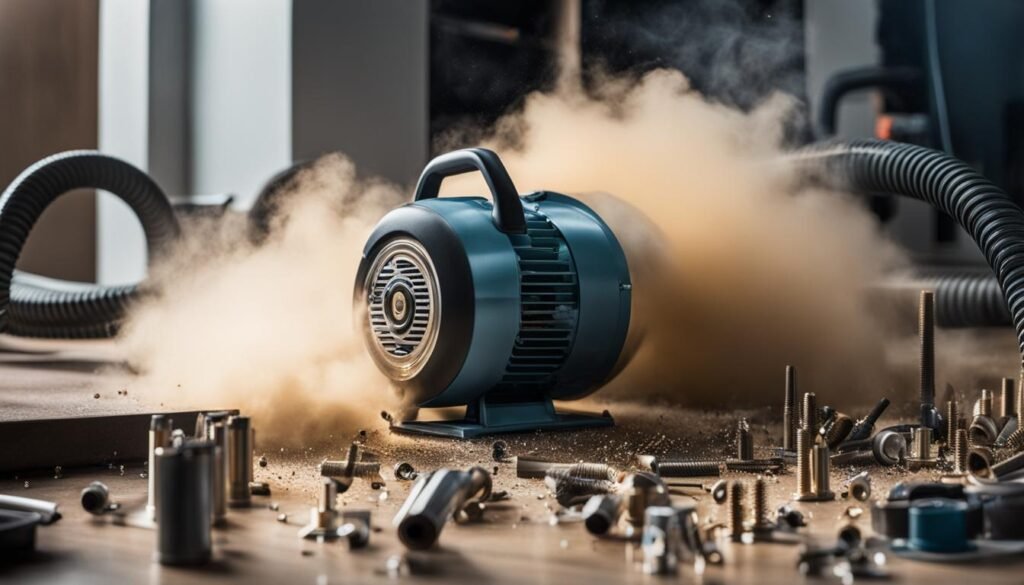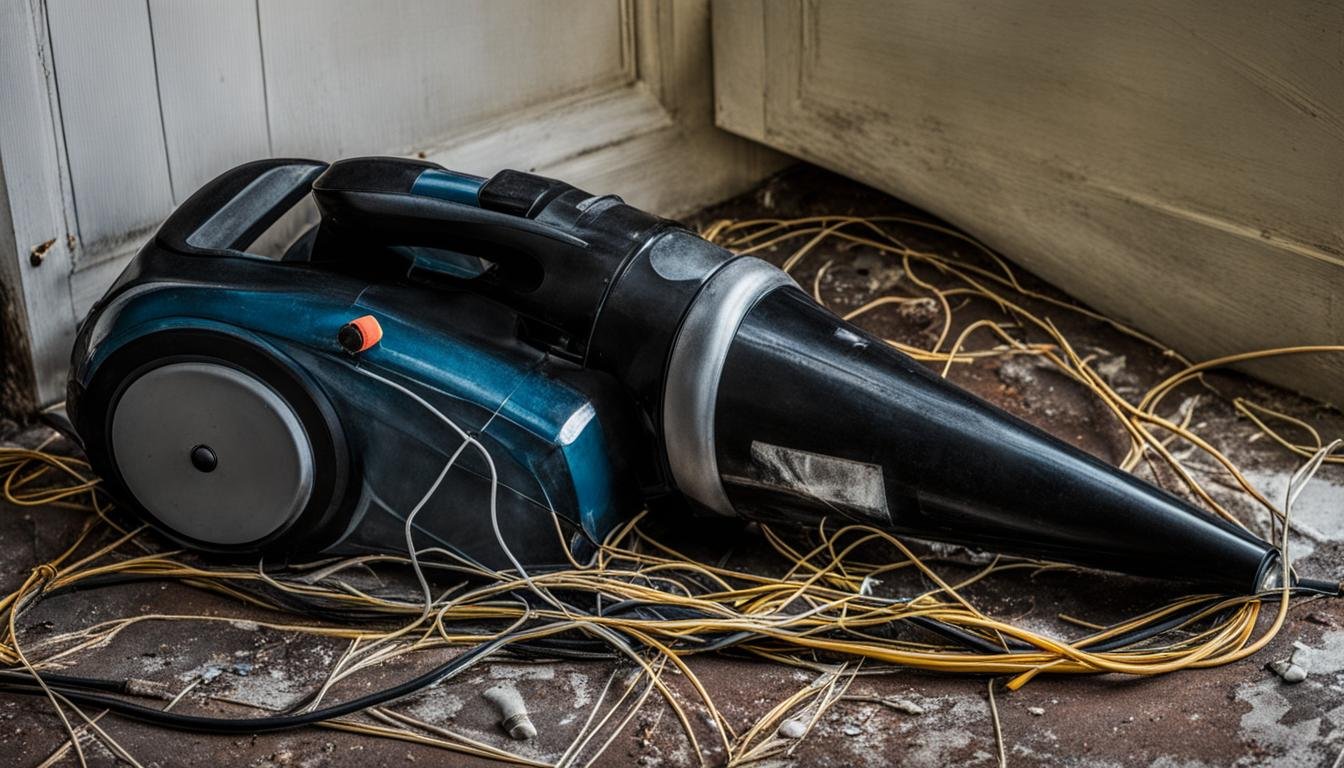If you’ve ever experienced the frustration of your vacuum cleaner suddenly stopping working, you’re not alone. It can be a real inconvenience when you’re in the middle of cleaning and your trusty appliance decides to give up on you. But fear not, there are common issues that can cause this sudden vacuum cleaner malfunction.
Loss of suction is one of the most common problems that can lead to your vacuum cleaner stopping working. This can be caused by a clog in the system or dirty filters that need to be cleaned or replaced. Another indication of a malfunction is a burning smell or a beater bar that isn’t moving, which could mean a broken belt that needs to be replaced. Additionally, your vacuum cleaner may shut off unexpectedly due to a clogged hose or incorrect surface settings. And if your vacuum won’t turn on at all, it could be a result of a faulty power switch or damaged cord.
Key Takeaways:
- Loss of suction, clogged hoses, and dirty filters are common causes of vacuum cleaner malfunction.
- A burning smell or a beater bar that isn’t moving could indicate a broken belt that needs to be replaced.
- A clogged hose or incorrect surface settings may cause the vacuum to shut off unexpectedly.
- If your vacuum won’t turn on, it could be due to a faulty power switch or damaged cord.
- Regular maintenance and cleaning can help prevent and troubleshoot common vacuum cleaner issues.
Troubleshooting Tips for Vacuum Cleaner Issues
When it comes to addressing vacuum cleaner issues, troubleshooting is key. Many common problems can be easily resolved with a few simple steps. Let’s take a look at some troubleshooting tips to get your vacuum cleaner back up and running efficiently.
1. Check for Clogs: Start by inspecting the nozzle, tube, and hose for any visible clogs. Blockages can restrict airflow and cause the vacuum cleaner to stop working properly. Use a long, flexible object such as a broom handle or a plumbing snake to remove any debris that may be lodged in the system.
2. Inspect and Clean the Filters: Dirty filters can also reduce suction power and prevent your vacuum cleaner from working effectively. Depending on the type of vacuum cleaner you have, locate and remove the filters. Rinse them under running water to remove dirt and debris. Allow the filters to dry completely before reinserting them into the vacuum cleaner.
3. Check the Dust Bag: If you have a bagged vacuum cleaner, make sure the dust bag is not full. An overly full dust bag can obstruct airflow and cause the vacuum cleaner to lose suction. Replace the dust bag if it is full to ensure optimal performance.
4. Cool Down: If your vacuum cleaner has been running for an extended period or has overheated, it may shut off or stop working temporarily. In such cases, allow the vacuum cleaner to cool down for a few hours before attempting to use it again.
5. Ensure Proper Connection: Check that the cable is securely connected to the power outlet and the vacuum cleaner itself. Also, inspect the cable for any signs of damage or fraying. Faulty wiring can disrupt the flow of electricity and prevent the vacuum cleaner from functioning correctly.
If these troubleshooting steps don’t solve the issue and your vacuum cleaner is still not working, it may be necessary to contact an authorized service center or the manufacturer for further assistance.
Remember, regular maintenance is key to preventing future issues with your vacuum cleaner. Take the time to clean the filters regularly and empty the dust bag or container as needed. By following these troubleshooting tips and practicing proper maintenance, you can keep your vacuum cleaner in excellent working condition for years to come.
| Issue | Possible Cause | Solution |
|---|---|---|
| Loss of suction | Clogs in the system or dirty filters | Check for clogs and clean/replace filters |
| Burning smell or beater bar not moving | Broken belt | Inspect and replace the belt |
| Vacuum shutting off unexpectedly | Clogged hose or incorrect surface settings | Check for clogs and adjust surface settings |
| Vacuum won’t turn on | Faulty power switch or damaged cord | Inspect and replace the switch or cord |
Potential Causes and Solutions for Vacuum Cleaner Failure
When your vacuum cleaner fails to work, it can be frustrating and inconvenient. Understanding the potential causes behind its malfunction can help you diagnose and fix the issue. Here, I will discuss common reasons why vacuum cleaners may stop working and provide solutions to get your vacuum cleaner up and running again.
Blocked Brush Rolls, Nozzles, or Hoses
One of the most common causes of vacuum cleaner failure is blockage in the brush rolls, nozzles, or hoses. Debris and tangled hair can accumulate over time, restricting airflow and preventing proper suction. To fix this issue, inspect these areas and remove any obstructions. You can use a pair of scissors or a brush to gently dislodge the clogs. Once cleared, your vacuum cleaner should regain its suction power.
Dirty Filters
Dirty filters can affect the performance of your vacuum cleaner and lead to its failure. Over time, dust and dirt accumulate in the filters, clogging them and reducing airflow. To resolve this problem, locate the filters in your vacuum cleaner and clean or replace them, depending on the manufacturer’s instructions. Regular maintenance of filters will help prevent future issues.
Full Dust Bag or Container
Another common cause of vacuum cleaner failure is a full dust bag or container. When the bag or container becomes too full, it can impede the vacuum’s airflow, resulting in reduced suction power or complete failure. To address this issue, check the dust bag or container and empty it if necessary. Make sure to follow the manufacturer’s guidelines on replacing or cleaning the dust bag to maintain optimal vacuum cleaner performance.
Overheating or Empty Battery
If your vacuum cleaner suddenly stops working, it may be due to overheating or an empty battery, especially for cordless models. Overheating can occur when the vacuum is used for prolonged periods without proper cooling breaks. In this case, turn off the vacuum, let it cool down, and then resume use. For cordless vacuum cleaners, if the battery is empty, charge it fully before attempting to use the vacuum cleaner again.
Wiring Problems or Defective Model
In some cases, vacuum cleaner failure can result from wiring problems or a defective model. Examine the power cord for any visible damage or loose connections. If you identify any issues, it is crucial to contact a professional repair center or the manufacturer for assistance. Additionally, if your vacuum cleaner is relatively new and continues to malfunction despite troubleshooting, it may be a defective model, and you should reach out to the manufacturer for a possible replacement or repair.
By understanding these potential causes and implementing the corresponding solutions, you can often resolve vacuum cleaner failures on your own. However, if the problem persists or requires technical expertise, it is recommended to seek professional vacuum cleaner repair services or contact the manufacturer for further assistance.

| Causes of Vacuum Cleaner Failure | Solutions |
|---|---|
| Blocked brush rolls, nozzles, or hoses | Inspect and remove blockages Clean brush rolls and hoses regularly |
| Dirty filters | Clean or replace filters according to manufacturer’s instructions |
| Full dust bag or container | Empty dust bag or container Follow manufacturer’s guidelines for replacement |
| Overheating or empty battery | Allow vacuum to cool down Charge battery fully for cordless models |
| Wiring problems or defective model | Contact professional repair center or manufacturer for assistance |
Conclusion
Fixing a vacuum cleaner that has suddenly stopped working doesn’t always require professional assistance. By troubleshooting and following the maintenance tips mentioned in this article, you can often resolve the issue yourself. Whether it’s a clogged hose, dirty filters, or a faulty power switch, taking the time to troubleshoot can save you time and money.
If the problem persists after troubleshooting, it is recommended to seek professional repair or contact the manufacturer for further assistance. They have the expertise to diagnose and fix complex issues that may be beyond your capabilities. Remember, it’s always better to be safe than sorry when it comes to repairing electrical appliances.
To prevent future issues with your vacuum cleaner, regular maintenance is key. Clean or replace filters as recommended by the manufacturer, empty the dust bag or container regularly, and check for any blockages in the nozzle, tube, or hose. By properly maintaining and using your vacuum cleaner, you can prolong its lifespan and ensure optimal performance for years to come.
FAQ
Why did my vacuum cleaner suddenly stop working?
There are several common issues that can cause a vacuum cleaner to suddenly stop working. Loss of suction may be due to a clog in the system or dirty filters. A burning smell or a stationary beater bar could indicate a broken belt that needs replacement. The vacuum shutting off unexpectedly may be caused by a clogged hose or incorrect surface settings. If the vacuum won’t turn on at all, it could be due to a faulty power switch or damaged cord.
What steps should I take to troubleshoot my vacuum cleaner?
When troubleshooting a vacuum cleaner that has stopped working, first check for any clogs in the nozzle, tube, or hose. If there are no visible clogs, inspect and clean the filters. For bagged vacuums, ensure the dust bag is not full and replace it if necessary. Letting the vacuum cool down for a few hours can help if it has overheated. Check that the cable is properly connected to the mains and look for any damage or wiring problems. If these steps don’t resolve the issue, contact an authorized service center for further assistance.
What are some common causes of vacuum cleaner failure?
Vacuum cleaner failure can be caused by various factors, such as blocked brush rolls, nozzles, or hoses, dirty filters, a full dust bag or container, overheating, empty battery, wiring problems, or a defective model. To solve these issues, check for blockages in the nozzle, tube, or hose and clean or replace the filters if necessary. Replace the dust bag if it is full and let the vacuum cool down or charge the battery if overheated or empty. Ensure that the cable is properly connected and check for any damage or wiring issues. If the vacuum cleaner still does not work, seek professional repair or contact the manufacturer for assistance.
Can I fix my vacuum cleaner myself?
While a sudden vacuum cleaner failure can be frustrating, there are often simple solutions to common problems. By troubleshooting and following the maintenance tips mentioned, you may be able to fix the issue yourself. However, if the problem persists, it is advisable to seek professional repair or contact the manufacturer for further assistance. Regular maintenance and proper usage can help prolong the lifespan of your vacuum cleaner and prevent future issues.





Leave a Reply